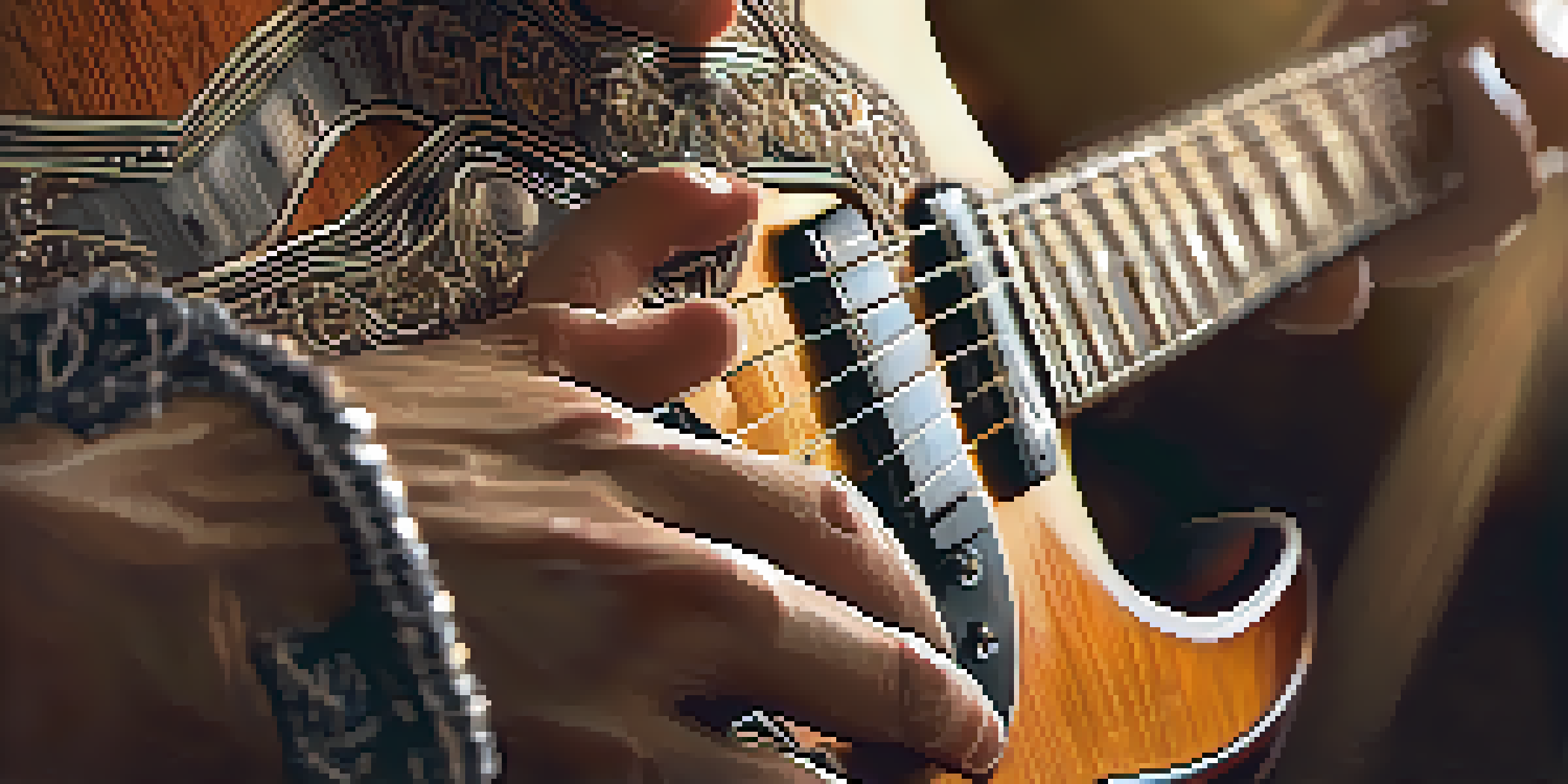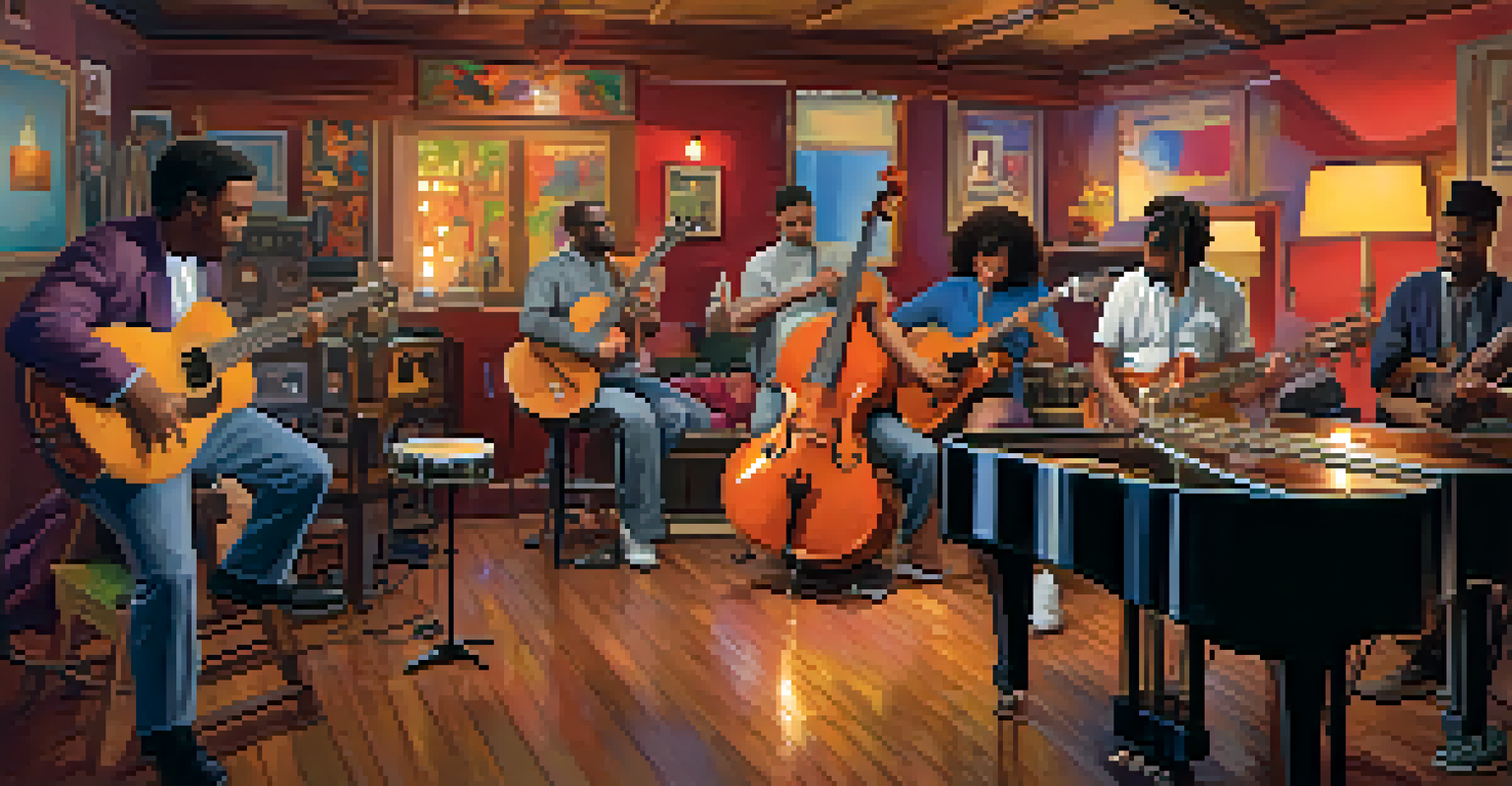Improvisation Techniques for Developing Guitar Creativity

Understanding the Basics of Improvisation on Guitar
Improvisation is the art of spontaneously creating music, and it's a vital skill for any guitarist. It allows you to express your emotions and ideas in real time, transforming a simple melody into something uniquely yours. By grasping the fundamentals of improvisation, you can unlock a world of creativity on your instrument.
Improvisation is the ability to create on the spot and the ability to play what you feel in the moment.
At its core, improvisation involves understanding scales, chords, and how they interact. For example, knowing the pentatonic scale can help you navigate through various genres, from blues to rock. This foundational knowledge provides a canvas upon which your musical ideas can flourish.
Remember, improvisation is not just about hitting the right notes; it's about conveying a feeling. Think of it like having a conversation with your guitar, where each note is a word, and the phrases you play form sentences that tell your musical story.
Exploring Scales: Your Toolbox for Creativity
Scales are the building blocks of musical improvisation, and they serve as your creative toolbox. Familiarizing yourself with different scales, such as major, minor, and blues, can open up new avenues for expression. Each scale has its own character, much like colors on an artist's palette.

For instance, the minor pentatonic scale is often used in rock and blues, providing a soulful sound that can evoke deep emotions. On the other hand, the major scale offers a brighter, happier tone, perfect for uplifting melodies. By experimenting with these scales, you can discover how they influence your improvisational style.
Improvisation Enhances Musical Expression
Improvisation allows guitarists to express emotions and ideas in real time, creating a unique musical narrative.
Try practicing these scales over backing tracks or with friends. This not only helps solidify your understanding but also encourages you to think creatively in real-time, making improvisation feel more natural and enjoyable.
Rhythm and Timing: The Heartbeat of Improvisation
While notes and scales are crucial, rhythm and timing are the heartbeat of your improvisational playing. Great improvisation isn’t just about what you play; it’s also about when you play it. Experimenting with different rhythms can add depth and excitement to your performance.
Music is the shorthand of emotion.
Think of rhythm as the dance of your notes. By varying your note durations, you can create tension and release, keeping your audience engaged. For example, a sudden shift from a steady beat to a syncopated rhythm can surprise listeners and elevate your musical narrative.
To develop your rhythmic skills, consider using a metronome or playing along with drum tracks. This practice will help you internalize different rhythms and allow you to improvise with greater confidence and flair.
Using Chord Progressions to Fuel Your Improvisation
Chord progressions provide a framework for your improvisation, guiding your melodic choices. Understanding common progressions, like the I-IV-V or ii-V-I, can help you anticipate the harmonic landscape as you play. This knowledge allows you to weave your melodies seamlessly into the music.
When improvising over a chord progression, try to outline the chords with your notes. For instance, emphasize the root notes of each chord to establish a strong connection with the harmony. This approach creates a sense of cohesion, making your solos sound more intentional and polished.
Scales and Chord Progressions Matter
Understanding scales and chord progressions provides the foundation for effective improvisation and melodic choices.
Don't hesitate to experiment by altering the progression slightly. Adding a chord or changing the order can lead to unexpected and exciting musical ideas that inspire your creativity.
Listening and Learning: The Key to Expanding Your Sound
One of the best ways to enhance your improvisational skills is through active listening. By immersing yourself in different genres and styles, you can absorb various techniques and approaches that resonate with you. This exposure will inform your own playing and inspire new ideas.
Try listening to solos from your favorite guitarists. Notice how they construct their phrases, how they use dynamics, and how they interact with the rhythm section. It’s like studying a master painter; you'll begin to see the strokes and techniques that make their work unique.
Make it a habit to transcribe solos that you admire. This process will deepen your understanding of improvisation and help you incorporate those influences into your own style, ultimately expanding your creative palette.
Experimenting with Different Genres for Broader Inspiration
Diving into different musical genres can significantly boost your improvisational creativity. Each genre has its own improvisational techniques and stylistic nuances that can enrich your playing. Whether it’s jazz, rock, blues, or classical, exploring these styles can offer fresh perspectives on your music.
For example, jazz improvisation often involves complex chord changes and a focus on melodic variations, while blues might emphasize expressive bends and phrasing. By incorporating elements from various genres, you can create a hybrid sound that’s uniquely yours.
Active Listening Expands Creativity
Listening to various genres and transcribing solos can inspire new ideas and techniques, enhancing your improvisational skills.
Challenge yourself to play outside your comfort zone by jamming with musicians from different backgrounds or learning songs from diverse genres. This experimentation will not only enhance your skills but also keep your musical journey exciting.
Developing Your Unique Voice through Improvisation
Ultimately, the goal of improvisation is to develop your unique musical voice. This is about expressing your individual experiences, emotions, and ideas through your guitar playing. The more you practice improvisation, the more you'll discover what sounds resonate with you.
Start by incorporating personal stories or feelings into your playing. For instance, if you’re feeling joyful, let that emotion shine through in your melodies. Conversely, if you’re in a reflective mood, create softer, more introspective phrases. Your guitar should be an extension of who you are.

As you develop your voice, remember that improvisation is a journey, not a destination. Allow yourself the freedom to explore, make mistakes, and grow. The more authentic you are in your playing, the more your audience will connect with your music.